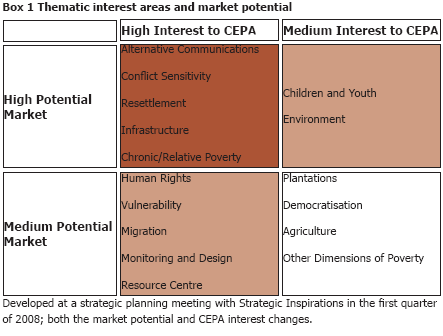CHAPTER 2 CHALLENGING THE ORGANISATIONAL CONCEPT |
 |
|
| Start > Chapter 1 > Chapter 2 (CHALLENGING THE ORGANISATIONAL CONCEPT) |
|||||
Does the organisational concept need redesigning? In 2005, the discussions that led to the formulation of CEPA’s 2005-2009 strategy confirmed CEPA’s vision of providing services, carrying out our own research and influencing policy, and envisaged an institutional structure that looked at the Poverty Impact Monitoring (PIM) and Poverty Assessment and Knowledge Management (PAM) programmes as long term, key programmes. These would be complemented by thematic programmes (i.e. programmes like the Poverty and Conflict programme) that were based on windows of opportunity, relevance to CEPA’s core mandate and interest both within and outside of the organisation. By 2008, the concept of key, long term programmes was being challenged, initially in financial terms. Long term funding for PAM (in the form of a Technical Assistance grant from the Asian Development Bank) came to an end, and there was no immediate funding for a second phase. PIM had had no programme funding for already two years, surviving largely on the ability of the team to bring in assignments. Even though poverty impact monitoring, poverty assessment and knowledge management continued to be the basis of what CEPA did as an organisation, the PIM and PAM teams did not find it easy to develop a strategic programme around the two concepts. Meanwhile, several other things were happening in CEPA. The Independent External Monitoring (IEM) of the Resettlement from the Southern Transport Development Project (STDP) led to the build up of CEPA’s capacity to carry out quantitative surveys, and with the recruitment of a senior part time statistician, it was agreed that this was an area that CEPA would want to strengthen. The IEM also stimulated an internal discourse on Q-squared methodology and CEPA’s application of combined qualitative and quantitative methods to gather data put CEPA in line with the global methodological discussion on mixed methods. These two developments helped PIM and PAM to define certain elements of their programme areas. PIM recognised that one of the programme’s key niches could be the exploring mixed methods for evaluations and PAM began to consider issues of quantitative measurements of the multiple dimensions of poverty. The work that PAM is doing with the Oxford Poverty and Human Development Initiative (OPHI), University of Oxford on multidimensional poverty will strengthen the team’s capacity to work quantitatively on these issues. Overall CEPA has definitely shifted from the mainly ‘qualitative’ orientation of previous years. Developing a strategic orientation around the PIM and PAM concepts were compounded by the difficulties of raising donor interest in supporting poverty impact monitoring methodology development, poverty assessments and knowledge management. The problem could be with CEPA’s inexperience in raising funding along these lines, or it could be that donors are more interested in providing funding to programmes dealing with particular issues (i.e. conflict, climate change, governance, migration, governance). As you will see in other parts of this report, some partnerships are being developed with regard to poverty assessments and knowledge management. We have already mentioned the work being done with OPHI as a partnership around poverty assessments. PAM’s links with the Institute of Development Studies in Sussex, UK, and their work on ‘IK mediaries’, its networking around evidence based policy making, and its leadership in the development of the CEPA poverty portal, all enhance the potential to develop support for knowledge management. However, given that the market seems to be more issue-based, it is possible that the ‘thematic programmes’ might need to become a stronger element of CEPA’s institutional concept. It may mean moving back to the pre-2005 matrix concept that balanced four programmes with four service areas (applied research, advisory services, dialogue and exchange and training). It may mean rethinking the programme concept and poverty impact monitoring, poverty assessment and knowledge management as core skills rather than strategic programmatic areas. In 2008, CEPA identified several themes through discussions among the senior professionals, management, and some of the directors and subscribing members, that are wide ranging, building on CEPA’s current expertise and interest (see box). They also attempt to abstract from the specific experience with clients to a more generalised conversation about poverty. None of these have materialised into significant long term programmes as yet, but all of them are being discussed and developed within CEPA’s existing programme structure. 
| |||||
|
|